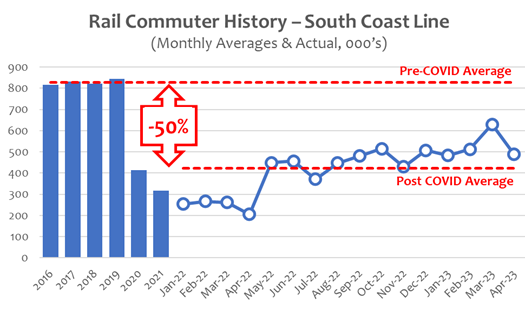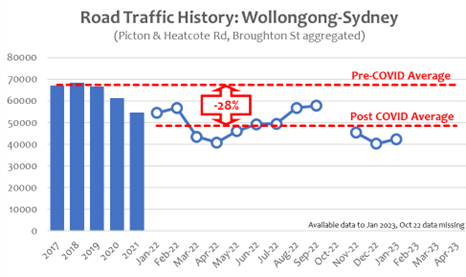Is the Wollongong to Sydney work commute dead?
Amid escalating debate about the value of encouraging staff back to the office, Illawarra workers have voted to reject the long commute.
New figures from TfNSW show rail travel on the South Coast Line post COVID has dropped by 50 percent when compared to the pre-COVID average.
In 2019, the monthly average for rail commuting on the South Coast Line, which runs from Bomaderry to Sydney, was more than 800,000 trips as workers made the daily journey to the office.
While figures show an increase in rail journeys throughout 2022 and early 2023, the post-COVID average sits just above 400,000 monthly trips, 16 months after restrictions were lifted.

RDA Illawarra CEO Debra Murphy said the figures show a marked change in the habits of Illawarra workers.
“The daily commute to work, whether that be from Kiama to Wollongong or from the Illawarra into Sydney, was once a hated but necessary fact of life for people in this region if they wanted to secure their dream job,” she said.
“COVID proved that with the technology available today, it is no longer necessary for many workers to spend up to four hours of their day travelling to and from the office and they have found a new work-life balance.
“The question is whether this will change in the future. Will workers heed the call for a full return to the office or job site, or will businesses need to permanently incorporate some type of hybrid working system in order to attract the best staff possible?”
While rail commuting has suffered a massive decline in the region post COVID, road traffic figures on some of the primary arterial roads are less dramatic according to TfNSW data.
Aggregated data for traffic on the Picton and Heathcote roads as well as Broughton St (near Camden) show a 28 percent drop in post-COVID average trips from almost 700,000 in 2019 to just under 500,000 throughout 2022.
Yet despite the reduction in traffic volumes, Picton Rd still records one of the highest proportions of heavy vehicle use (at 25%) of any road in the county. Although it is predominantly single lane each way, the undivided road carries 60 percent of the traffic volume that the four-lane divided Hume Highway does – with a higher proportion of heavy vehicles.

While road traffic history is harder to quantify in relation to the work commute, Ms Murphy says data analysis indicates workers are considering their options when it comes to employment.
“COVID changed the playing field and has shown both businesses and workers that there are many factors to be considered when it comes to accessing jobs and suitable employees,” she said.
“It could mean Illawarra businesses have greater ability to employ locally or large corporations could consider satellite regional sites for their businesses in order to reduce travel times. It could mean workers negotiate on wage expectations in favour of a hybrid remote working environment.
“Either way, the data shows the debate is far from over.”
